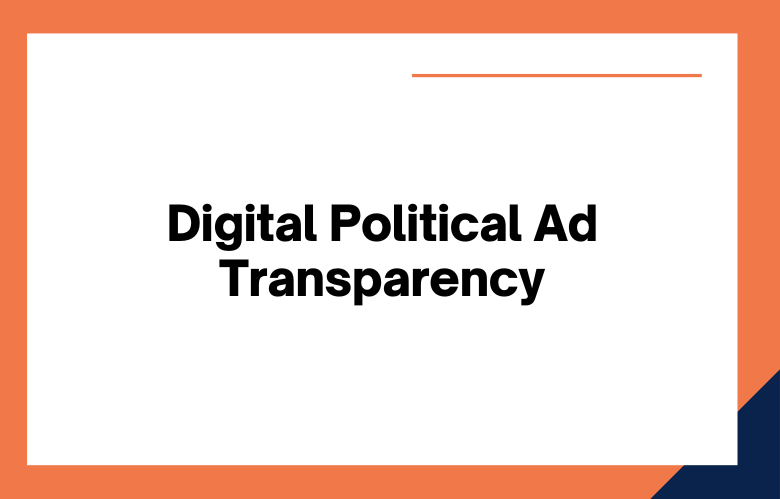Digital political ad transparency is becoming more pressing as we head into the election. With ever-evolving technology, it’s harder to track where ads are coming from and who is funding them. The blog post teaches you how to research your opponent’s advertising so that you can make informed decisions to put your money during election season.
Stay ahead of the curve and learn how to fight fire with fire!
In today’s digital world, it’s easier than ever for political candidates to run ads on social media platforms like Facebook and Twitter. But what happens when you want to research these ads? How can you make the claims being made in them truthful?
We’ll show you how to research political ads and their sources so that you can make informed decisions about whom to vote for in the upcoming election.
Political campaigns are now relying more than ever on digital advertising. For a successful campaign, voters must be aware of the messages sent through these ads. We will outline a few ways that voters can research the advertising of their opponents.
An excellent resource for investigating digital political ads is YouTube. By typing in a specific candidate’s name and adding “ad” after it, you will pull up any advertisements they have released online. Often these videos are uploaded directly from the candidate’s official YouTube channel.
Another way to research digital political ads is through social media platforms like Facebook and Twitter. Candidates often post screenshots of their ads on their official pages as well as on their campaign staff’s pages.
Following candidates and other influential people involved in politics on social media will likely see many screenshots of digital political ads as they are released.’
What is Digital Political Ad Transparency?
Digital political ad transparency is a requirement for online platforms to make public information about who is purchasing political ads on their site. It includes the sponsor’s identity, how much to spend, the target audience, and contact information for the sponsor.
Digital political ad transparency is a requirement for online platforms to make public information about who is purchasing political ads on their site.
It includes the sponsor’s identity, how much to spend, the target audience, and contact information for the sponsor.
Sites that don’t adhere to the guidelines can face significant fines from the Federal Election Commission.
Digital Political Ad Transparency is a project led by a cross-sector consortium of Italian and international organizations. The project aims to increase online political advertising transparency and help build a more inclusive, pluralistic, and deliberative democracy.
It is essential in the current media landscape because online platforms increasingly influence public opinion. Still, there is little regulation around these ads and how they target. As a result, the risk is that only certain voices hear, exposing people to biased or distorted information.
To mitigate the risk is digital political ad transparency, which would require online platforms to inform the public about who is behind an ad, how much it spends on it, and who it targets. It allows voters to make informed choices and hold political campaigns and committees accountable for the ads they run.
Digitalpoliticaladtransparency.com is a website that seeks to increase the transparency of digital political ads. The site creates by two passionate individuals about campaign finance reform.
The website permit users to search for and view digital political ads shared on social media platforms. Users should leave comments and ratings on the ads, which aids in the overall goal of increasing transparency.
Digital political ad transparency is a way of ensuring that online political ads are clearly labeled and disclosed. This way, voters can make informed decisions about which candidates to support.
Digital political ad transparency is essential because it protects the democratic process. Without it, voters would be in the dark about who is trying to influence them. So, what is digital political ad transparency? It’s a crucial part of maintaining a fair and democratic society.
How to Research Opponent Political Advertising using Digital Political Ad Transparency
To research your opponent’s political ads, start by looking for the “Digital Political Ad Transparency” section on their website. It gives you a good idea of their ads and where they are running them. You can also try searching for their ads on social media platforms like Facebook and Twitter.
You can use the Digital Political Ad Transparency tool to research your opponent’s political ads.
This tool allows you to see how much money your opponent is spending on ads and which platforms they use to reach voters.
You can also see which topics their ads focus on and get an idea of their overall messaging strategy.
Using the tool, you better understand your opponent’s election strategy and plan your campaign accordingly.
Ways to Research Opponent Political Advertising
- Look up your opponent’s donor list and research their top contributors
- Use online search engines to find articles about your opponent and their stances on specific issues
- Visit your state’s Board of Elections website to view financial disclosures filed by your opponent
- Go to the Federal Election Commission website to see how much money has been raised and spent by both candidates
- Subscribe to email alerts from news organizations that will send you updates when new stories about your race are published
- Follow social media accounts of reporters who are covering the election, as they will often share insights into what the campaigns are doing behind-the-scenes
- Attend political events and rallies for both candidates and take note of who is speaking, what they’re saying, and how people are reacting
- Look at the sponsor’s website
- Google, the organization sponsoring the ad
- Look up the CEO or other leaders of the organization
- Check out their Wikipedia page
- Search for articles about them in major publications
- See if they’re on social media and follow them to see what they’re saying
- Watch the ads yourself to get a sense of what they’re saying
- Look up fact-checking websites to see if the claims in the ad are true
- See if any news outlets have covered the ad and what they said about it
- Compare the ad to speeches or policy proposals from the candidate
- Use social media to see how people are reacting to the ad
- Look at the organization’s website.
- Look at their social media platforms, especially Twitter.
- Read articles about them in reputable publications like The New York Times or The Washington Post.
- Watch videos of them on YouTube or other video-sharing sites.
- Follow them on Twitter to see what they’re talking about and how they’re trying to appeal to voters.
- Use Google to search for the name of your opponent’s campaign and “political advertising.”
- Visit websites like OpenSecrets.org and ProPublica to learn more about who is funding your opponent’s campaign.
- Watch videos of your opponent giving speeches or talking to reporters on TV or YouTube.
- Read articles about your opponent in credible publications like The New York Times, Washington Post, or Politico.
- Follow your opponent’s Twitter account to see what they’re saying and retweeting.
- Check out your opponent’s Facebook page to see what kind of content they share with their fans.
- Watch the ads and take note of their key points.
- Look up information about the organization behind the ad
- Compare the claims in the ad to what is true
- See if any celebrities or other public figures have endorsed the ad
- Check out who is funding the ad campaign
- Research how effective the ad is likely to be
- Look at the organization’s website to learn about their stances on issues
- Search for articles written by or about the organization and read what they have to say
- Watch videos of the organization talking about their beliefs
- Follow them on social media platforms like Twitter, Facebook, and Instagram
- See if any of their representatives are giving speeches or participating in debates
- Google the organization and research their positions on various issues
- Watch videos of the opposing candidate advertising to get an idea of their messaging
- Read articles about the organization sponsoring the ad and how they’ve contributed to politics in the past
- See if any watchdog groups have rated or criticized the advertisement
- Follow social media accounts for candidates and organizations sponsoring ads to see what people say about them.
Conclusion
Political ad transparency is a critical part of any democracy. As we head into the home stretch of this year’s election, it’s more important than ever to know whom to fund political ads and what those ads are saying.
We work with clients to ensure their advertising is transparent and compliant with all relevant regulations. If you’re keen to learn about digital political ad transparency that can help your campaign or organization, please don’t hesitate to contact us.
We would be happy to measure our expertise and answer any questions you may have. Thank you for reading!
Digital Political Ad Transparency: How to Research Opponent Political Advertising – FAQs
What Is Digital Political Ad Transparency
Digital political ad transparency refers to the practice of clearly disclosing the source, funding, targeting criteria, and intent behind political advertisements displayed online.
Why Is Transparency Important In Digital Political Advertising
Transparency helps maintain trust in the democratic process by ensuring voters know who is behind the messages they see and why they are being targeted.
How Can Political Campaigns Disclose Ad Funding Sources
Campaigns can include disclaimers within ads, link to transparency pages, and provide details in ad metadata on platforms that support disclosure.
What Are The Key Elements Of A Transparent Political Ad
Key elements include the sponsor’s name, funding source, ad creation date, targeting criteria, and access to an archive of all versions of the ad.
How Do Digital Platforms Enforce Political Ad Transparency
Platforms like Facebook, Google, and Twitter have political ad archives, identity verification processes, and disclosure requirements for advertisers.
What Role Does Disclosure Play In Building Voter Trust
Disclosure ensures accountability, reduces misinformation, and allows voters to make informed judgments about the credibility of political messages.
How Can Voters Verify The Authenticity Of Online Political Ads
Voters can check platform ad libraries, review transparency disclaimers, and cross-reference information with official campaign sources.
What Are The Legal Requirements For Digital Political Ad Transparency
Requirements vary by country but often include sponsor identification, spending limits, and public reporting of ad targeting and funding.
How Can Technology Improve Transparency In Political Advertising
Technologies like blockchain, AI-driven monitoring, and automated reporting systems can enhance tracking, verification, and public access to ad data.
What Is The Impact Of Transparency On Voter Decision Making
Transparency can improve voter confidence, reduce susceptibility to manipulation, and promote more informed political choices.
How Do Ad Libraries Contribute To Political Ad Transparency
Ad libraries store and publicly display information on all political ads, including spending, targeting, and engagement metrics, for public review.
What Are The Challenges Of Implementing Transparency In Digital Political Ads
Challenges include inconsistent regulations across regions, lack of enforcement, evolving digital ad formats, and advertiser attempts to bypass rules.
How Can Political Campaigns Avoid Misinformation In Digital Ads
By fact-checking all claims, avoiding manipulative imagery, and ensuring messaging is backed by verifiable sources.
What Role Does AI Play In Political Ad Monitoring
AI can detect suspicious ad patterns, flag undisclosed sponsorships, and track the spread of misinformation across platforms.
How Can Real-Time Reporting Improve Political Ad Transparency
Real-time reporting ensures voters and regulators have immediate access to ad information, reducing the window for deceptive practices.
What Are The Penalties For Non-Compliance With Transparency Rules
Penalties can include fines, removal of ads, account suspensions, and, in some jurisdictions, legal action against the advertiser.
How Can Transparency Regulations Vary Between Countries
Some countries have strict, centralized rules, while others rely on platform self-regulation or have minimal transparency requirements.
What Best Practices Should Campaigns Follow For Ad Transparency
Best practices include proactive disclosure, consistent record-keeping, accessible transparency reports, and compliance with all local regulations.
How Can Collaboration Between Platforms And Regulators Improve Transparency
Collaboration enables better data sharing, consistent standards, and faster enforcement of political ad transparency rules.
What Future Trends Are Emerging In Digital Political Ad Transparency
Trends include AI-powered verification, standardized global disclosure frameworks, and public blockchain registries for all political ads.
One way to get in touch is by filling out our online form on this site or give us a call at
+91 9848321284. Let’s work together today!











